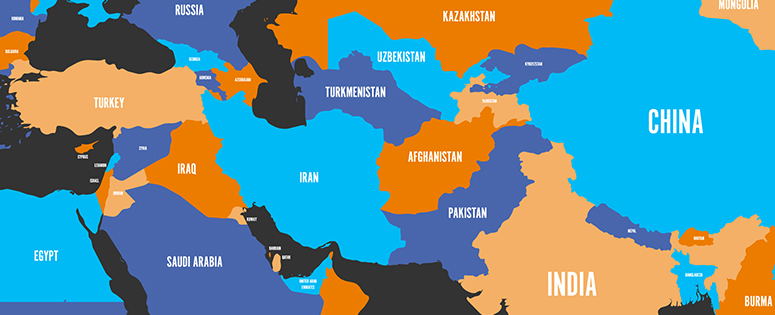In the first semester of 2017, Gulf politics were marked by numerous international events. Among them, three had a distinct significance. First, Sheikh Mohamed bin Zayed Al Nahyan, crown prince of Abu Dhabi, travelled to Delhi at the end of Januarywhere he was invited as guest of honor to the celebration of India’s Republic Day, a privilege given in the recent past to the former US and French Heads of State, Barack Obama and Francois Hollande. Four weeks later, the ruler of Saudi Arabia, King Salman, embarked on a historical month-long Asia tour that brought him to Indonesia, Brunei, Malaysia, Japan, and China. Lastly, in June, in the midst of the biggest diplomatic crisis within the Gulf Cooperation Council opposing Qatar to Saudi Arabia and others, Turkish President Erdogan announced the speeding up of Turkey’s military base in Doha, its first overseas military permanent deployment since the fall of the Ottoman Empire.
These three episode highlight one common development: Gulf strategic partnerships are no longer exclusively looking at the US and Western traditional powers and eye increasingly towards Asia. These new ties do not serve as a substitute but have a pragmatic purpose: to send a signal to Washington. In other words, this Gulf-Asia rapprochement can be understood as a way for Arab rulers to hedge against the declining influence of the US.
This new geopolitical landscape is the result of two separate trends from the last decade. First, from the chaotic reconstruction of Iraq after the fall of Saddam Hussein to the inconsistencies of the Obama policy in the Middle East, the unpredictability of US policy in the region grew and caused local actors to diversify their strategic options.
Second, the growth of Asian economies – in particular India, China, Japan, and South Korea – is now driving oil markets. This means by extension that Asia’s economic ties to the Gulf are becoming more consequential than those of Western powers with Arab oil producers. If we exclude the US, the four biggest importers of oil in the world are today in Asia: China, India, Japan and South Korea which total 40.6% altogether of oil purchases in 2016. Over the next fifteen years, China, India and the members of the Association of Southeast Asian Nations (ASEAN) will define the global energy consumption, leaving the countries of the OECD far behind.
The conjunction of these two trends has several ramifications. To start with, economic interdependence begets common security interests. The flow of commodities from the Arab peninsula to the Asia Pacific region relies on regional and maritime stability. Any trouble onshore (e.g. failed State, civil war) or offshore (piracy attacks) can disrupt this movement. This is why the last years have been marked by an increased role of Gulf and Asian navies in counterpiracy operations in the Indian Ocean. Likewise, Gulf stability is becoming a security priority for Asian countries, as evidenced by documents such as China’s Arab Policy Paper.
This interdependence may rely on Gulf oil supplies but it is widening its scope to include other sectors. A South Korean consortium has been building the UAE’s first nuclear plants since 2009. Saudi Arabia aims to follow the same path as it signed partnerships for its own nuclear program with South Korea and China. Investments in infrastructures also play a central role in Gulf relations with India and China, especially as countries like Saudi Arabia aim to position them as regional hubs for China’s Belt and Road Initiative. In addition to these economic indicators, Gulf-Asia ties are also visible in the military domain. High level visits between military commanders increased, multiple defense agreements were signed and followed by numerous cooperation programs in the field of military education or joint training.
If this rapprochement is significant, does it mean a geopolitical revolution in the Gulf? One has to remain cautious: as of today, it does not mean a realignment of Gulf countries between the US and Asian powers. At the military level, it is unlikely that any country – be it China or India – could and would replace both the resources and the security guarantees provided by the US to the Peninsula. Moreover, the strategic rapprochement between Gulf and Asian countries may also be impeded by the way it impacts – as well as is impacted by – the local competitions. For instance, it is not clear how Gulf countries, which historically have had a strong military relationship with Pakistan, could strengthen their strategic dialogue with India without challenging their ties to the former. This is why this new geopolitical landscape should neither be ignored nor overestimated. In any event, given the current foreign policy style of the Trump presidency, the logic of hedging – meaning for Gulf countries to diversify their international relations and to cover against the US unpredictability – is likely to become the new pattern of Gulf strategies but it remains to be seen how much it will affect the regional security system on the long term.
* The views expressed in this paper are strictly those of the author. They do not reflect the views of the UAE National Defense College, or the government of the United Arab Emirates.
Jean-Loup Samaan
Associate Professor in Strategic Studies
UAE National Defense College
First Published at “In Depth Volume 14, Issue 6, December 2017″

